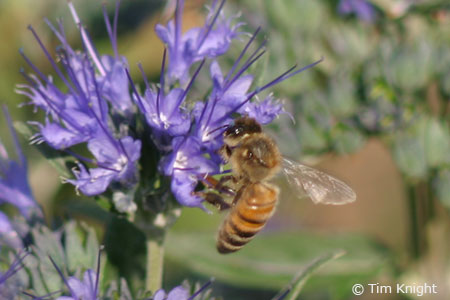

|
Honey bee (Apis mellifera) Description: Honey bee is a widely distributed flying insect know for its ability to collect nectar from flowers and produce honey. Honey bees (right) are mustard yellow and brown. They have stocky bodies that are covered with many hairs to which pollen adheres. The honey bee's primary commercial value is as a pollinator of crops. Another bee that you might encounter in Washington is the orchard mason bee (Osmia lignaria). The orchard mason bee is usually slightly smaller than a honey bee and is shiny dark blue in color. The orchard mason bee is a gentle beneficial insect that has potential as a pollinator of apples, cherries, and other tree fruits. It is found throughout most of North America, particularly in wooded areas but often around homes in towns and cities. The orchard mason bee is non-aggressive and will sting only if handled roughly (source: WSU).
Honey bees are not native to the Americas but were introduced by European settlers. The first introductions are believed to have occurred in the early to mid 1600s by English and Spanish settlers. Beekeepers actively imported a number of different European subspecies from 1859 to 1922. Diet: Honey bees harvest nectar (carbohydrates) and pollen (protein) from flowering plants. They are not attracted to meats like the yellowjackets.
Behavior: Honey bees are social insects that live in large colonies. The queen bee, drones and worker bees all have specific tasks to help support the colony. The queen bee lays hundreds of eggs. The male drones' main function is to be ready to fertilize a receptive queen.Worker bees do all the different tasks needed to operate and maintain the hive. Why bees sting: A honey bee that is away from the hive foraging for nectar or pollen will rarely sting, except when stepped on or roughly handled. Honey bees will actively seek out and sting an intruder when they perceive that hive is threatened. They are often alerted to the danger by the release of attack pheromones by other honey bees. When a bee or wasp stings, it injects a venomous fluid under the skin of the victim (see photo). Honey bees have a barbed stinger. Only the honey bee leaves her stinger - with its venom sac attached - in the skin of its victim. It normally takes two to three minutes for the venom sac to inject all of the venom, so instant removal of the stinger and sac usually reduces harmful effects. (source: osu.edu) Reproduction: The queen bee lays all of the eggs in a colony. At the height of the season, she may lay over 2,500 eggs per day! The queen fertilizes each egg as it is being laid using stored sperm from the spermatheca. The queen occasionally will not fertilize an egg. These non-fertilized eggs, having only half as many genes as the queen or the workers, develop into male drones.
Did you know?

Honey bee collecting nectar. photo by Tim Knight More information: |
Animal silhouettes available to purchase »
Photos: Tim Knight; Waugsberg (bee sting)
Home | About Us | How to Participate | Biodiversity Modules | Projects | Maps | News | Resources